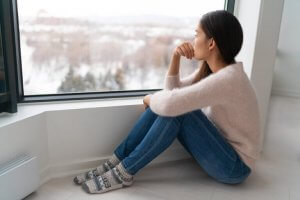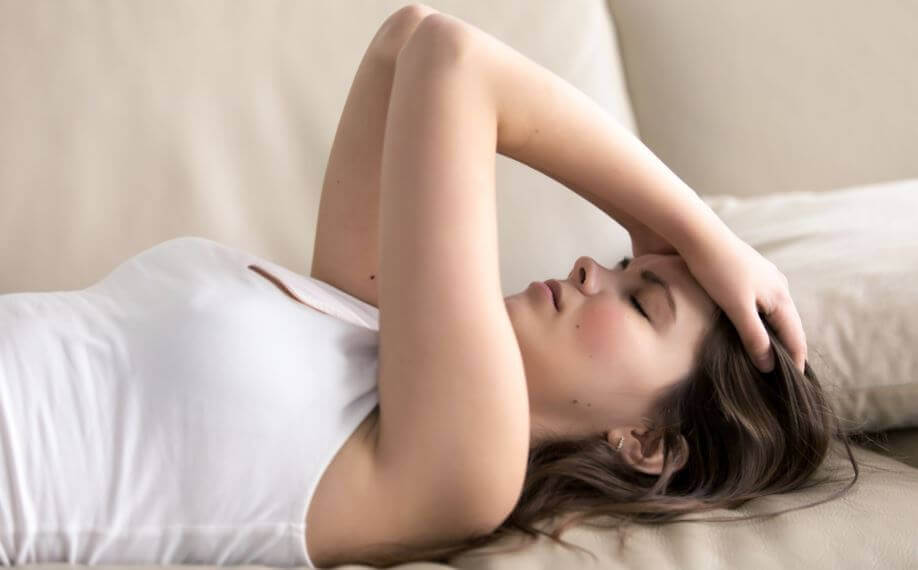Physical Exercise to Combat Depression and Anxiety

New forms of therapy for depression and anxiety, such as physical exercise, are a hot topic in psychology. Since the past century, there have been two main ways to combat these mental disorders: drugs prescribed by a doctor and psychotherapy.
However, more and more professionals are pointing out the importance of an active lifestyle to prevent and combat psychological distress.
Even though they may seem strange, depression and anxiety are very much present in today’s society. According to data from the World Health Organization, 4.4 percent of the world population suffers from depression. Furthermore, experts estimate that by 2030 depression will be the leading cause of disability.
If we talk about anxiety, 10.4 percent of the population in Europe suffers from an anxiety disorder. These numbers reflect that problems such as depression and anxiety aren’t isolated cases; in reality, they affect a large number of people.
What are the symptoms of depression and anxiety?
Although depression and anxiety have different symptoms, the reality is that they share a very close relationship. It’s common for a person to have symptoms of both disorders, or to receive a diagnosis of depression and anxiety at the same time.
Depression can have different levels of severity. Some of its most common symptoms are:
- Feelings of sadness and lack of motivation.
- Loss of interest in daily activities.
- Guilt feelings.
- Changes in sleep and appetite patterns.

- Lack of attention and difficulty concentrating.
- In more severe cases, there may be suicidal thoughts.
On the other hand, anxiety disorders include a multitude of ailments: specific phobias, generalized anxiety disorder, panic disorder, etc. What they all have in common is an extreme concern for the future and the anticipation of negative and fatal events.
Psychological effects of physical exercise
Physical exercise not only has benefits for the body, but it also affects our psychological well-being for four reasons:
- Increases monoamine release. After exercise, the brain releases dopamine, endorphins, and serotonin. These substances generate a feeling of tranquility, well-being, and happiness.
- Fulfills the goals and objectives. Upon reaching their goals and objectives, the brain activates the person’s reward system. When this happens, we feel great satisfaction and joy.
- Improves self-esteem. Changes in body appearance, along with the feeling of achievement by progress, positively influence our self-esteem.
- Reduces social isolation. When doing physical exercise in a group, the interaction with other people increases. This way, the person feels supported and loved within a group.
Physical exercise as a therapy for depression and anxiety
As we’ve already seen, physical exercise brings benefits for both the body and mind. Still, there’s a very important question: can physical exercise prevent and cure psychological discomfort?
Combat depression with physical exercise
Physical exercise has been proven to be an effective measure to treat depressive symptoms. Physical activity on a moderate level is an alternative treatment for people suffering from sleep disorders; remember that one of the main symptoms of depression was changes in sleeping patterns.
On the other hand, there’s no single effective exercise modality. Specialists have carried out interventions with different activities, such as aerobic exercise, strength training, dance, yoga, and hydrotherapy, all of them with positive results in the psychological well-being of the studies’ subjects.

We should note that, although physical activity decreases the symptoms of depression, it’s still a condition that a health professional should evaluate. Following the guidelines that they establish, we should combine physical exercise with psychotherapy sessions.
Combat anxiety with physical exercise
Just as physical exercise can help treat depression, anxiety can also decrease with an active lifestyle. In a study by the University of Cork, researchers found a negative relationship between levels of physical activity and anxiety.
On top of that, people who practiced collective sports were also the ones with lower levels of anxiety. This discovery reinforces the benefits of group exercise compared to individual exercise.
Likewise, physical activity improves the quality of life of people with chronic illnesses. A study by Epilepsy & Behavior states that a sedentary lifestyle is a risk factor for developing anxiety in people with epilepsy. Therefore, physical exercise can not only help treat anxiety but can also prevent it in people with other conditions.
Conclusion
In summary, physical exercise has therapeutic effects to combat depression and anxiety. Leading an active and healthy lifestyle is beneficial not only for our physical health but for our mental health as well. However, we can’t forget that mental disorders must be diagnosed and assessed by a specialist.
New forms of therapy for depression and anxiety, such as physical exercise, are a hot topic in psychology. Since the past century, there have been two main ways to combat these mental disorders: drugs prescribed by a doctor and psychotherapy.
However, more and more professionals are pointing out the importance of an active lifestyle to prevent and combat psychological distress.
Even though they may seem strange, depression and anxiety are very much present in today’s society. According to data from the World Health Organization, 4.4 percent of the world population suffers from depression. Furthermore, experts estimate that by 2030 depression will be the leading cause of disability.
If we talk about anxiety, 10.4 percent of the population in Europe suffers from an anxiety disorder. These numbers reflect that problems such as depression and anxiety aren’t isolated cases; in reality, they affect a large number of people.
What are the symptoms of depression and anxiety?
Although depression and anxiety have different symptoms, the reality is that they share a very close relationship. It’s common for a person to have symptoms of both disorders, or to receive a diagnosis of depression and anxiety at the same time.
Depression can have different levels of severity. Some of its most common symptoms are:
- Feelings of sadness and lack of motivation.
- Loss of interest in daily activities.
- Guilt feelings.
- Changes in sleep and appetite patterns.

- Lack of attention and difficulty concentrating.
- In more severe cases, there may be suicidal thoughts.
On the other hand, anxiety disorders include a multitude of ailments: specific phobias, generalized anxiety disorder, panic disorder, etc. What they all have in common is an extreme concern for the future and the anticipation of negative and fatal events.
Psychological effects of physical exercise
Physical exercise not only has benefits for the body, but it also affects our psychological well-being for four reasons:
- Increases monoamine release. After exercise, the brain releases dopamine, endorphins, and serotonin. These substances generate a feeling of tranquility, well-being, and happiness.
- Fulfills the goals and objectives. Upon reaching their goals and objectives, the brain activates the person’s reward system. When this happens, we feel great satisfaction and joy.
- Improves self-esteem. Changes in body appearance, along with the feeling of achievement by progress, positively influence our self-esteem.
- Reduces social isolation. When doing physical exercise in a group, the interaction with other people increases. This way, the person feels supported and loved within a group.
Physical exercise as a therapy for depression and anxiety
As we’ve already seen, physical exercise brings benefits for both the body and mind. Still, there’s a very important question: can physical exercise prevent and cure psychological discomfort?
Combat depression with physical exercise
Physical exercise has been proven to be an effective measure to treat depressive symptoms. Physical activity on a moderate level is an alternative treatment for people suffering from sleep disorders; remember that one of the main symptoms of depression was changes in sleeping patterns.
On the other hand, there’s no single effective exercise modality. Specialists have carried out interventions with different activities, such as aerobic exercise, strength training, dance, yoga, and hydrotherapy, all of them with positive results in the psychological well-being of the studies’ subjects.

We should note that, although physical activity decreases the symptoms of depression, it’s still a condition that a health professional should evaluate. Following the guidelines that they establish, we should combine physical exercise with psychotherapy sessions.
Combat anxiety with physical exercise
Just as physical exercise can help treat depression, anxiety can also decrease with an active lifestyle. In a study by the University of Cork, researchers found a negative relationship between levels of physical activity and anxiety.
On top of that, people who practiced collective sports were also the ones with lower levels of anxiety. This discovery reinforces the benefits of group exercise compared to individual exercise.
Likewise, physical activity improves the quality of life of people with chronic illnesses. A study by Epilepsy & Behavior states that a sedentary lifestyle is a risk factor for developing anxiety in people with epilepsy. Therefore, physical exercise can not only help treat anxiety but can also prevent it in people with other conditions.
Conclusion
In summary, physical exercise has therapeutic effects to combat depression and anxiety. Leading an active and healthy lifestyle is beneficial not only for our physical health but for our mental health as well. However, we can’t forget that mental disorders must be diagnosed and assessed by a specialist.
All cited sources were thoroughly reviewed by our team to ensure their quality, reliability, currency, and validity. The bibliography of this article was considered reliable and of academic or scientific accuracy.
- De Lima, C., de Lira, C. A. B., Arida, R. M., Andersen, M. L., Matos, G., Guilhoto, L. M. D. F. F., … y Vancini, R. L. (2013). Association between leisure time, physical activity, and mood disorder levels in individuals with epilepsy. Epilepsy & Behavior, 28(1), 47-51.
-
González, I., Gómez, N., Ortiz, R., & Ibarra, V. (2018, December). Ejercicio físico como tratamiento adyuvante de los trastornos mentales. Una revisión narrativa. In Anales de la Facultad de Ciencias Médicas (Vol. 51, No. 3, pp. 27-32).
-
McMahon, E. M., Corcoran, P., O’Regan, G., Keeley, H., Cannon, M., Carli, V., … y Balazs, J. (2017). Physical activity in European adolescents and associations with anxiety, depression and well-being. European Child & Adolescent Psychiatry, 26(1), 111-122.
This text is provided for informational purposes only and does not replace consultation with a professional. If in doubt, consult your specialist.








